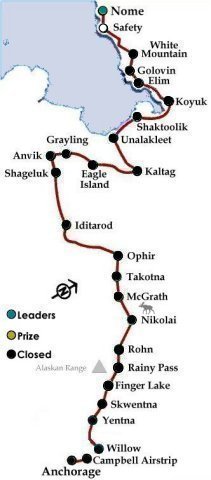Race Day 6 – Iditarod
 The Dorothy Page Halfway Award and $3,000 in gold nuggets go to Lance Mackey (47), or, more properly, to his 16 superdogs. They made the run from Ophir in under 10 hours, just over 9 mph. In fresh snow that’s amazing.
The Dorothy Page Halfway Award and $3,000 in gold nuggets go to Lance Mackey (47), or, more properly, to his 16 superdogs. They made the run from Ophir in under 10 hours, just over 9 mph. In fresh snow that’s amazing.
Only Kim Darst (52)R and Rob Loveman (50)R have yet to arrive in McGrath.
The weather is forecast to get colder, which is good news for the dogs. Cold weather during the daylight also helps Rachael Scdoris (58), who is totally blind at night.
The Current Standings [12:50 AM CDT]:
1 Lance Mackey (47)
2 Aaron Burmeister (56)
3 Hugh Neff (55)
4 Sebastian Schnuelle (34)
5 Ken Anderson (54)
6 Jeff King (41)
7 Mitch Seavey (21)
8 Paul Gebhardt (15)
9 John Baker (44)
10 Cim Smyth (37)
11 Hans Gatt (25)
12 Aliy Zirkle (24)
13 Dallas Seavey (62)
14 Warren Palfrey (7)
15 Jessie Royer (17)
16 Bruce Linton (40)
17 Ramey Smyth (16)
18 Aaron Peck (2)
19 DeeDee Jonrowe (31)
20 Ed Iten (4)
21 Sonny Lindner (42)
22 Gerry Willomitzer (14)
23 Matt Hayashida (19)
24 Gerald Sousa (36)
25 Martin Buser (33)
26 Rick Swenson (8)
27 Cindy Gallea (49)
28 Jim Lanier (35)
29 Linwood Fiedler (28)
30 Rick Larson (5)
31 Judy Currier (22)
32 Melissa Owens (30)
33 Ray Redington Jr (10)
34 Sven Haltmann (53)
35 Ryan Redington (13)
36 Robert Bundtzen (51)
37 Karin Hendrickson (29)R
38 Chad Lindner (26)R
39 David Sawatzky (66)
40 Bill Cotter (65)
41 Ed Stielstra (46)
42 Allen Moore (6)
43 Mike Williams (39)
44 Jake Berkowitz (12)
45 Harry T Alexie (67)R
46 Jeff Holt (68)
47 Eric Rogers (60)
48 Michael Suprenant (11)R
49 Jen Seavey (61)R
50 Wade Marrs (48)R
51 Robert Nelson (23)
52 Rachael Scdoris (58)
53 Tim Osmar (57)
54 Tom Thurston (27)R
55 Laura Daugereau (45)
56 Heather Siirtola (63)
57 Trent Herbst (20)
58 Timothy Hunt (64)R
59 Alan Peck (32)R
60 Kurt Reich (59)R
61 Lou Packer (43)R
62 Blake Matray (9)R
63 Kim Darst (52)R
64 Rob Loveman (50)R



































5 comments
Woo Hoo, Lance! They must have had a busy night! It’s amazing what dogs will do for human beings. Then again, based on all the howling and excitement the dogs show at starting off, apparently they love it too.
Well, they didn’t run the Quest this year, so they had extra energy, but that speed is really amazing, He has a 3 hour lead at the moment, but the snow is deep to the Yukon at Anvik, so they’ll tire eventually.
The trail breakers have been making on 3mph on snowmobiles on the next stretch.
Oh, so this is where the deep snow is located. I had heard something about unusual snowfall on parts of the trail but didn’t get where exactly it was. Thanks.
Does being out in front have both it’s good and bad points? For example, doesn’t the front runner occasionally have to break trail under certain conditions.? On the other hand, if you’re behind, you can get a rutted trail from prior sleds. So, it seems it would depend on the conditions whether one would rather be out front or in the rear.
Speaking of deep snow, do you have an idea of the snow’s depth in those areas at this time of year? I’ve often wondered what the snow pack is under the trail.
Real Life intruded, Juanita.
This area is open to the Bering Sea so they get a lot of storms, however the winds usually blow the snow even further inland, and it evaporates in the normal super-cold air, so you don’t see the snow pack that they experience in Colorado, the area is more like the Great Plains.
He was definitely breaking trail through about two feet of new snow that wasn’t the blow-away fluff you get around Fairbanks. In the interior it takes 10 quarts of snow to produce a quart of water.
Because of the warming, what people were concerned about was the back-breaking wet snow that you get on the East Coast. The stuff that makes the rock hard snow balls and freezes into ice ridges. As teams move through that the sleds run in the ruts until you start dragging the body of the sled, and people break runners when they hit the ruts.
Lance may have found the right time to follow the trail breakers, i.e. there was still a trail packed down by the snowmobile belt, and it wasn’t rutted. The people behind him are going to be dealing with the ruts. Obviously he judged it properly, and chose to continue while the situation was optimal.
Running up the Yukon is an entirely different set of problems, jumbled ice the biggest among them. If the snow moved up the Yukon Valley things will be a lot smoother than usual, but the ice blocks usually eat a few sleds.
Update: The secret to Lance’s success was that he waited until the top melted in the sun and warm temperatures, then froze after sundown. He was running on the resulting crust that was thick enough to support him.
As long as the crust doesn’t break, things will be fast and smooth. The two feet of snow is waiting to swallow the unlucky.